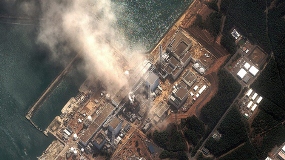Japan Prepares for a Long Struggle with Crippled Reactors
March 29, 2011
Featured Image
Today's top nuclear policy stories, with excerpts in bullet form.
Stories we're following today - Wednesday, March 30, 2011:
Confidence Slips Away as Japan Battles Nuclear Peril – Ken Belson and Hiroko Tabuchi in The New York Times [link]
- After workers switched on the first set of control room lights at Japan’s crippled power plant in Fukushima last week, the Japanese government offered its strongest assurances yet that its nuclear crisis was close to being under control.
- The recent flow of bad news from the Fukushima Daiichi Nuclear Power Station has undermined the drumbeat of optimistic statements by government and company officials who have at times tried to reassure a nervous public that significant progress is at hand — only to come up short.
- The setbacks have raised questions about how long, and at what cost, Japan can keep up what experts call its “feed and bleed” strategy of cooling the reactor’ fuel rods with emergency infusions of water from the ocean and now from freshwater sources.
- Moreover, the discovery of radioactive elements that experts say could come only from the core of a reactor suggest that the government’s strategy may not be working and that partial fuel melting has not been completely halted.
- The risks that Japan could export its nuclear problems by allowing radioactive contaminants to get into the air and sea are among the reasons why the government and Tokyo Electric have enlisted the help of experts from France, the United States and elsewhere to make sure conditions do not spiral out of control.
Getting to Low Numbers of Nuclear Weapons – Julian Borger for The Guardian [link]
- After the New Start treaty, with its modest reductions in the US and Russia nuclear arsenals, barely scraped through the US Senate in December, there is not a great deal of optimism around for a follow-on arms control agreement any time soon.
- Against this gloomy backdrop, James Acton, a nuclear policy expert at the Carnegie Endowment for International Peace, has brought out a practical guide to the seemingly impossible.
- “...reducing the US and Russian stockpiles to 500 nuclear warheads each and those of other nuclear-armed states to no more than about half that number. This target would require Washington and Moscow to reduce their arsenals by a factor of ten.”
- The secret to avoiding 'strategic instability' on the way to such low figures, Acton argues, lies in a comprehensive and verifiable approach.
- Two years after the bright dawn of Barack Obama's Prague speech on eliminating nuclear weapons, arms control advocates are struggling with despondency. Acton at least offers a pragmatic route back to hope.
Top Republican Remains Opposed to Nuclear Test Ban – Global Security Newswire [link]
- The 12 years since the Comprehensive Test Ban Treaty was rejected on Capitol Hill have not offered reasons for reversing course in favor of the global ban on nuclear trial blasts, U.S. Senator Jon Kyl said on Tuesday.
- "I've seen nothing in the ensuing time to suggest that if we forever give up our right to test" other countries would follow suit, the Senate Minority Whip said during a discussion at the Carnegie Endowment for International Peace Nuclear Policy Conference.
- The United States has observed a self-imposed moratorium on atomic bomb blasts since 1992. It has signed but not ratified the test ban treaty.
- When the Senate last took up the pact in 1999, opponents, led by Kyl, argued it would prohibit tests that might prove necessary to verify the reliability of the U.S. stockpile. Skeptics also wondered whether treaty states might be able to conduct clandestine nuclear tests without being detected.
- The global lattice of CTBT detection sites is expected to be 90 percent complete before the start of 2013, the head of the agreement's implementing body said last year. Today, the network boasts 265 certified monitoring and laboratory installations.
Chinese Pieces to Iran's Nuclear Puzzle - Bertil Lintner for The Asia Times [link]
- Iran has always denied that it has a nuclear weapons program, insisting that its research into atomic energy is for strictly peaceful purposes. If that were the case, skeptics argue, there should be more transparency and less secrecy surrounding the country's procurement of materials for its defense industries.
- The United States, European Union and United Nations have all imposed sanctions on Iran over its nuclear program. However, Iran's attempts to procure nuclear-related materials through unorthodox channels predates those restrictions.
- The easiest way to source such materials has always been to use a middleman in a third country, which is then declared as the end user of items actually destined for Iran. Dubai in the United Arab Emirates (UAE) was previously the re-export hub for these clandestine activities, and for years Iran imported more goods through Dubai than its own ports.
- Because the US in particular now has better cooperation from the UAE, Iran is increasingly turning to countries and territories like China, Hong Kong, Taiwan and Malaysia to obtain what it needs to keep its contested nuclear industry running.
- Authorities in Hong Kong, the world's third-largest port, have begun to enforce more vigorously the territory's export laws, and even Malaysia - a country often mentioned in this context - has introduced tougher measures.



